
Shopify is a service that gives a great opportunity to use the eCommerce platform as a subscription service. With Shopify, you can easily create an online store with the full stack of shopping cart features so that you are able to sell, ship, and manage your products. When using the service, you are going to be able to benefit from the admin panel that is rich on features that are necessary for online stores. Thus, a fully functional online store is going to cost you something around $30 per month. Moreover, Shopify offers a variety of plans to fulfill the needs of all its customers. More details on each plan is available on Shopify with their posted information on Lite Plan, Basic Shopify Plan, Shopify Plan, Advanced Shopify Plan, Shopify Plus Plan.
How to Set Up a Shopify Store
When you are thinking about Shopify, just give it a try and go for the registration.This way, you are going to see what Shopify has to offer. As a Shopify development company, we'll now share quick and easy tips to launch a Shopify store.
Sign up with Shopify
Registering and logging in with Shopify is an easy process that can be done with Shopify on a desktop. Another way to use Shopify is to run it from the Shopify app for iPhone or Android.
Every time when you log in to the Shopify platform, you are going to need to enter your credentials on the login page. If you enter the password incorrectly, you will need to complete the verification process to make sure you are not a robot. Also, if your browser is in incognito mode or if you cleared your browsing history, you will need to complete verification steps as well. However, none of this is really a time-consuming thing but a method of protection against hacking attempts of unauthorized access to your store.
Setting up an online store
After you logged in successfully, you will see the admin screen of your store. It is time for you to start customizing your store, uploading your items to the store, and setting up payment systems and shipping options. Basically, your admin page is the basic information source for what you need to do to maintain your store up and running.
Choosing a design for a store
When you are only starting your online store, you are going to use the official theme of the Shopify store. Practically, there is a variety of themes to choose from, and when you are starting your business, it is relatively easy to choose the theme that reflects the idea of your store. The most important thing is that the themes that are used for setting up the store are supported by Shopify designers. This means that you are in good hands and you are going to get help and support even when you’re choosing a free Shopify theme to use.
In addition, Shopify offers a range of paid themes so that you can have a brighter design. Premium themes usually have more modification options and a slicker design. Usually, premium themes cost between $100 and $180. However, it is a good investment if you have a lot of products in your inventory. With the large inventory and many themes to use, you can get a fitting look instantly at a reasonable price.
Edit Shopify settings
With a free theme, you can achieve great looks too. However, you need to have some knowledge in editing the theme. To change the way that the theme looks, you need to edit the HTML and CSS code of the theme. However, even if you do not have any coding experience, you will be able to change the theme with an international team of designers. Practically, Shopify experts are able to customize the theme in almost no time. To get quick and effective help, contact Shopify professionals, who are able to help you with editing the theme or to customize any design of yours for your store.
Add your products
After you registered and chose your theme, you will need to add a product to your Shopify store. Once properly set up, the Shopify platforms will take you right to the admin page, where you can customize the store and add products so that your customers have enough items to browse through and choose from. When you are going to customize our backend, you are going to see a nice step-by-step instruction to add a product.
When adding the product, you will be redirected to the Add product page. On the page, you are going to need to fill in details like a title, description, price, and vendor. For all the fields available, you will need to fill in the ones that you need first of all. When filling in the data, keep in mind that proper images are going to increase your chances to sell the product while poor ones might reduce your chances for sales. In addition, you are getting a chance to customize the page for your needs, for example, if you sell clothes, you might set the pages to fill in details like a title, description, price, and vendor.
With Shopify, you are going to have a feature of showing the products in different collections, which is even easier for your customers to browse and find the item they want. Moreover, when adding a collection to your store, you are going to select how exactly your products are going to be displayed on the webpage. Specifically, you might add the criteria for the products to meet that define if the products can be added to the inventory automatically.
Customize the Look of Your Shopify Website
When having the online store and the inventory developed, it is time to customize the looks of your website. To do that, use the button Customize the Look of Your Site. This button allows customizing almost everything on the website, from logos and colors to the design. To customize the theme you are using, use the link named Visit the Theme store.

Add a domain name
One of the last but not least steps to do is to choose a domain name for the online store. Generally, there are two choices to fulfill this step. The first one is to buy a domain name from Shopify, and in this case, you’re getting a domain name automatically. This choice saves your time and costs nearly $9-$14 per year. Another choice is to buy a domain name from a third party, such as GoDaddy. The choice of the domain from the third party is nearly $10 per year, but there is a downside of the need to redirect the DNS records yourself. This can be a daunting task, so just contact us if you need quick help with this or any other step in the process of setting up the Shopify store.
Read further: Cost to Have a Shopify Store
Activate Your Payment Processor
When you are ready to sell, make sure you have set up the payment processors. To do that, go to the dashboard called Payments. This dashboard has a wide range of payment processors that you might use for your online store. In addition, Shopify has got its own payment method, which is very easy to implement and use. For all payment processors, there are the steps to follow that are listed so you can activate any payment processor you need.
However, you will need to choose whichever payment processor you need, depending on transaction fees, card types, and offsite checkout.
- The transaction fees: it goes without saying, you will want to choose the payment gateway with the lowest possible price. Just search for it.
- Card types: you can choose whatever car types and payment systems you need to process, including PayPal and Stripe.
- Offsite checkout: some payment gateways will take the payment process away from your website, and this is a slightly more secure choice. However, remember that it might be a pain for your customers.
Summary
If you were successful in all these steps, you get a fully functional Shopify store, and you can start earning.
The process of setting up the Shopify store seems to be complicated at first, but if you have enough time and knowledge, you are going to nail it. Either way, we are happy to hear from you at any step of the process. The SOFTLOFT company is one of the leading Shopify-certified development teams, and we are only a click away from helping you, just contact us and share your pain with us. We are always happy to hear from you.



